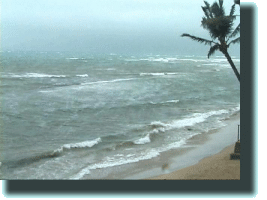
| Our dive site looked like a witch's brew 33K JPEG |
It was a dark and stormy night...
Well, ok, so it wasn't dark... and it wasn't night... but it was stormy! For a few hours, our dive site looked like a witch's brew.

| Our dive site looked like a witch's brew 33K JPEG |
The wind howled and whipped the sea into a frenzy, and rain poured down in streams. As we watched, memories of 1993 came back to haunt us, raising fears of a muddy red ocean for the rest of the summer. Forunately, it never got that bad, and by the next day conditions were back to our normal "lousy" for 2000.
This kind of storm goes away.
There is a "storm" of a different kind that never goes away--and for the turtles living here, it's deadly.
Two summers ago, a small turtle made her home under a comfortable ledge in 25 feet of water. She was beautiful and because 1998 was the 25th Anniversary of the sea turtle tagging programme at French Frigate Shoals we named this youngster "Makana", Hawaiian for "gift" ("gift" from French Frigate Shoals).
Last summer she was accompanied by an even smaller turtle, a turtle so tiny we decided to call her Akebono in the hopes she'd grow up to the impressive dimensions of a Sumo wrestler.
Makana and Akebono often played together 43K JPEG | 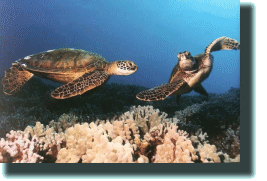
|
Makana and Akebono often played together. This usually meant Akebono would swim over to a resting Makana and flit and pester until the larger turtle lifted and the game of chase-and-tag was on.
Even then, the signs were there.
Makana was showing white abnormalities in the posterior of both her eyes. White blemishes appeared on her neck and shoulders. In our experience, this "white" signals the beginning of fibropapilloma (FP) disease.
Akebono also worried us. In late August 1999, ultra-close inspection of her eyes showed a coarsening or warping in the posterior of her eyes too. We feared this too would lead to FP by the July 2000.
This week we sighted both Makana and Akebono. What a difference 10 months makes.
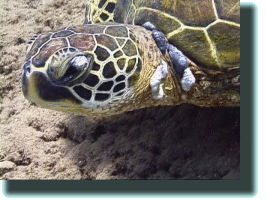
| Makana, 10 months later 60K JPEG |
At this point, from where we sit, we're prepared to stick out our necks and make a pronouncement about the turtles and fibropapilloma disease at Honokowai. They all get it. All of them. If they hang around Honokowai long enough they all get FP.
Hindsight being what it is, and since we now know what to look for, and with the honu letting us get close enough to tell... we can separate the turtles here into three categories:
Those that have FP... 37K JPEG | 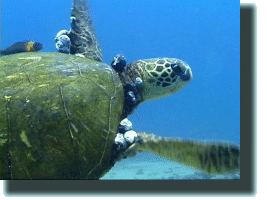
|
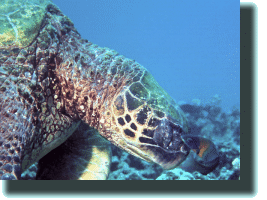
| ...those that have had FP... 56K JPEG |
...and those that are getting FP 41K JPEG | 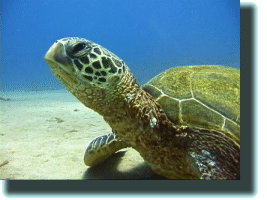
|
Frequently we've been asked to put a number on the FP rate at this site. We're not even sure what that means. Is "FP rate" the number of turtles with visible tumors? Certainly that's what FP rate means in most applications.
What about the number of turtles who have had the disease and regressed, however? Should they not be counted in the FP rate for turtles resident in the area?
Should turtles showing first signs of the disease (just not showing true tumors) also factor into the FP rate?
We continue to wrangle with these and other questions.
Over the years, we've collected and studied the progression of FP as it worked its nastiness on literally hundreds of honu. We believe that careful examination, particularly of the eyes, can reveal the earliest onset of FP. Based on this and our observations this summer, we are willing to make a bold statement: If turtles hang around Honokowai long enough, they all get FP.
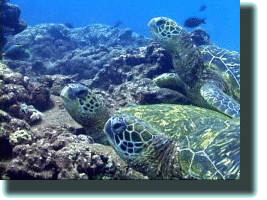
| If turtles hang around Honokowai long enough, they all get FP 65K JPEG |
Summer 2001 will either support our hypothesis or discredit it. We'll have to wait and see. That's the way it is diving here. No sooner do we get answers then new ones are raised and we must wait another summer for a different set of answers.
We were in the coral garden on our way back from a dive, when Peter spotted a small turtle. She swam and Peter followed. As she got over sand the little honu headed straight for Ursula, who then settled in the sand videotaping the turtle's approach.
Neither of us recognized the turtle at first. Peter could only see the rear shell and Ursula only the head of the turtle straight-on. (We need to see their faces in order to know who's who!)
As the little honu got closer, Ursula expected the turtle to veer left or right but she did neither. Instead the turtle swam straight ahead and then tucked herself right under Ursula! Even then we didn't recognize the turtle.
Only after the turtle scrambled out from under and showed us her profile did we recognize our little friend Makana. Makana, "Gift" from the Shoals.
Sometimes we get so protective of them. So attached. No--make that too attached.
 Who's Who Underwater at Honokowai
Who's Who Underwater at Honokowai